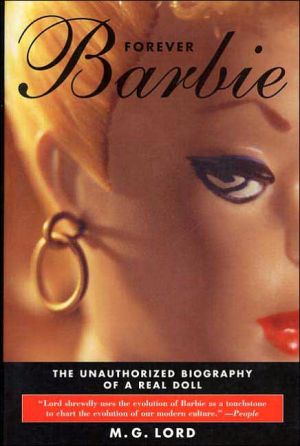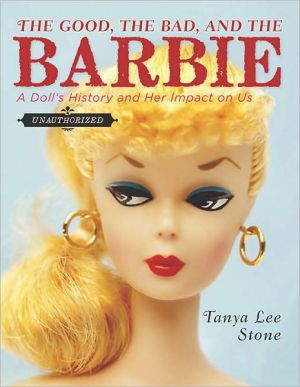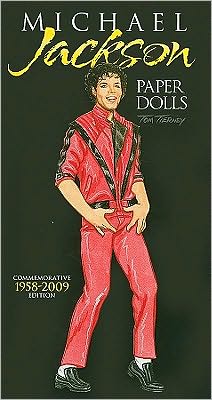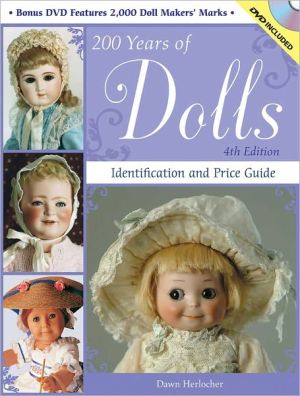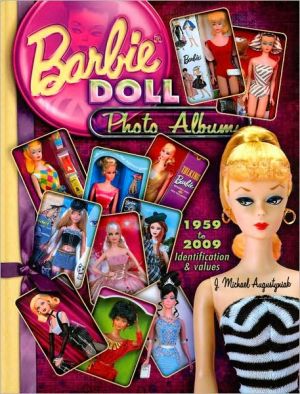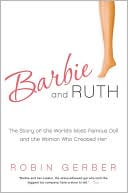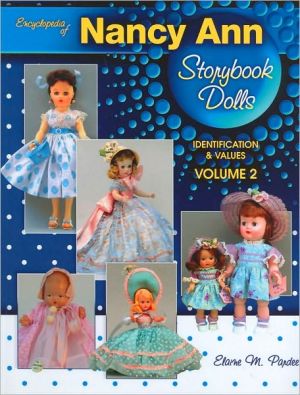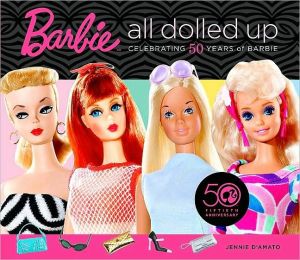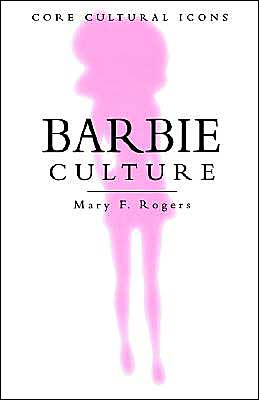Forever Barbie: The Unauthorized Biography of a Real Doll
Since Barbie's introduction in 1959, her impact on baby boomers has been revolutionary. Far from being a toy designed by men to enslave women, she was a toy invented by women to teach women what— for better or worse— was expected of them. In telling Barbie's fascinating story, cultural critic and investigative journalist M. G. Lord, herself a first-generation Barbie owner, has written a provocative, zany, occasionally shocking book that will change how you look at the doll and the world.\ \...
Search in google:
Since Barbie's introduction in 1959, her impact on baby boomers has been revolutionary. Far from being a toy designed by men to enslave women, she was a toy invented by women to teach women what— for better or worse— was expected of them. In telling Barbie's fascinating story, cultural critic and investigative journalist M. G. Lord, herself a first-generation Barbie owner, has written a provocative, zany, occasionally shocking book that will change how you look at the doll and the world."Fascinating ... compelling .... A seriously wry, thoroughly researched and totally enlightened look at the doll that most of us either love or love to hate."— Newsday"Scathing, hilarious ... consistently informative and amusing."— San Francisco Chronicle"Its mix of social history, psychoanalytical insights, and the Mattel marketing schemes that evoke them is told with wit, curiosity, and wry photos."— Los Angeles Times Book Review"Terrific .... A book that was dying to be written .... A crisp, often witty love story of American pop culture."— The Boston Globe"The author's enthusiasm is infectious and she writes with considerable wit .... Her subject inspires passion."— The New York TimesM. G. Lord is an author and critic. Since 1995 she has been a regular contributor to the New York Times Book Review and the New York Times Arts & Leisure section. Her work has appeared in numerous publications, including the New Yorker, the Wall Street Journal, Vogue, the Los Angeles Times Book Review, and ARTnews. She lives in Los Angeles.Publishers WeeklyThe original ``Barbie,'' an 111/2 fashion model doll with an hourglass figure, was introduced to the American public in 1959 and has been a bestseller ever since. In this witty and perceptive study Lord, a columnist for New York Newsday, chronicles Barbie's history and her relevance as a cultural icon. Ruth Handler, co-owner of Mattel Toys, modeled Barbie on a sexy plastic German pin-up that was sold to men in tobacco shops. The popularity of Barbie and her ever-expanding wardrobe with preteen girls led to the development of ``Ken'' and ``Midge'' dolls and a line of African American fashion dolls. Lord's comprehensive research includes interviews with toy-makers, an eclectic group of Barbie collectors, visual artists and feminists who disagree on Barbie's impact on young girls. The author sees Barbie, whose careers have included surgeon, pilot and astronaut, as a female role model, and credits her childhood play with Barbie as helping her cope with her own mother's mastectomy. Illustrations.
Forever Barbie\ The Unauthorized Biography of a Real Doll \ \ By M. G. Lord \ William Morrow & Company\ Copyright © 1994 M. G. Lord\ All right reserved. \ ISBN: 0688122965 \ \ \ Chapter One\ WHO IS BARBIE, ANYWAY? \ The theme of the convention was "Wedding Dreams," and appropriately it was held in Niagara Falls, the honeymoon capital, a setting of fierce natural beauty pimpled with fast-food joints and tawdry motels. The delegates were not newlyweds who had come to cuddle aboard the Maid of the Mist, poignantly hopeful that their union, unlike half of all American marriages, would last. They were not children, who had come to goggle at the cataract over which dozens of cartoon characters had plunged in barrels and miraculously survived. Nor were they shoppers attracted by Niagara's other big draw-the Factory Outlet Mall-where such brand names as Danskin and Benetton, Reebok and Burberrys, Mikasa and Revere Ware could be purchased for as much as 70 percent off retail.\ They were, however, consumers, many of whom had been taught a style of consumption by the very object they were convening to celebrate. They had fled the turquoise sky and the outdoor pagentry for the dim, cramped ballroom of the Radisson Hotel. There were hundreds of them: southern ladies in creaseless pant suits dragging befuddled Rotary Club-member husbands; women in T-shirts from Saskatoon and Pittsburgh; stylish young men from Manhattan and West Hollywood. There were housewives and professional women; single people, married people, severely corpulent people, and bony, gangling people. A thirtysomething female from Tyler, Texas, volunteered that she had the same measurements as Twiggy, except that she was one inch wider in the hips. There were people from Austria and Guadeloupe and Scotland. Considering the purpose of the gathering, there were surprisingly few blond people.\ These were delegates to the 1992 Barbie-doll collectors' convention, a celebration of the ultimate American girl-thing, an entity too perfect to be made of flesh but rather forged out of mole-free, blemish-resistant, non-biodegradable plastic. Narrow of waist, slender of hip, and generous of bosom, she was the ideal of postwar feminine beauty when Mattel, Inc., introduced her in 1959-one year before the founding of Overeaters Anonymous, two years before Weight Watchers, and many years before Carol Doda pioneered a new use for silicone. (Unless I am discussing the doll as a sculpture, I will use "she" to refer to Barbie; Barbie is made up of two distinct components: the doll-as-physical-object and the doll-as-invented-personality.) At other collector events, I have witnessed ambivalence toward the doll-T-shirts, for instance, emblazoned with: "I wanna be like Barbie. The bitch has everything." But this crowd took its polyvinyl heroine seriously.\ Of course, people tend to take things seriously when money is involved, and Barbie-collecting, particularly for dealers, has become a big business. The earliest version of the doll, a so-called Number One, distinguished by a tiny hole in each foot, has fetched as much as $4,000. The "Side-part American Girl," which features a variation on a pageboy haircut, has brought in $3,000. And because children tend to have a destructive effect on tiny accessories, the compact from Barbie's "Roman Holiday" ensemble, an object no bigger than a baby's thumbnail, has gone for $800. While Barbie-collecting has not replaced baseball as the national pastime, it has, in the fourteen years since the first Barbie convention in Queens, New York, moved from the margins to the mainstream. Over twenty thousand readers buy Barbie Bazaar, a glossy bimonthly magazine with full-color, seductively styled photos of old Barbie paraphernalia. And twenty thousand is not an insignificant number of disciples. Christianity, after all, started out with only eleven.\ In the shadowy salesroom, amid vinyl cases and cardboard dreamhouses, thousands of Barbies and Barbie's friends were strewn atop one another-naked-suggesting some disturbing hybrid of Woodstock and a Calvin Klein Obsession ad. Others stood bravely-clothed-held up by wire stands. Some were in their original cartons; "NRFB" is collector code for "never removed from box." Still others were limbless, headless, or missing a hand. "Good for parts," a dealer explained. Buyers, wary of deceitful dealers, ran weathered fingers over each small, hard torso, probing for scratches, tooth marks, or, worst of all, for an undeclared spruce-up. Even a skillful application of fresh paint can devalue a doll, as does hair that has been rerooted.\ Emotions ran high as deals were cut. A stocky woman in jeans haggled furiously over Barbie's 1963 roadster; I later saw her in the lobby, cradling the car as if it were her firstborn child. Others schmoozed with reliable, well-known dealers-Los Angeles-based Joe Blitman, author of Vive La Francie, an homage to Francie, Barbie's small-breasted cousin who was born in 1966 and lasted until 1975; and Sarah Sink Eames, from Boones Mill, Virginia, author of Barbie Fashion, a photographic record of the doll's wardrobe. I learned the value of established dealers when I bought "Queen of the Prom," the 1961 Barbie board game, from a shifty-eyed woman who was not a convention regular. "The set's kind of beat-up," she told me, "but all the pieces are authentic." Right, lady. Barbie's allowance, I discovered when I played the game, was five dollars. The smallest denomination in the set she sold me was $100. (The bills were from another game.)\ Selling was not the only action at the convention. There was a fashion show in which collectors arranged their not-especially-Barbie-esque bodies into life-size versions of their favorite Barbie outfits. There was a competition of dioramas illustrating the theme "Wedding Dreams"; one, which did not strike me as lighthearted, featured a male doll (not Ken) recoiling in fear and horror from Barbie and, implicitly, Woman, on his wedding night. (His face had been whitened and his eyes widened into circles.) Employees of Mattel were treated like rock stars. Early on the second night of the convention, veteran costume designer Carol Spencer, who has been dressing Barbie since 1963, settled down in the hotel lobby to autograph boxes of "Benefit Ball Barbie," one of her creations in Mattel's Classique Collection, a series promoting its in-house designers. At eleven, she was still signing.\ Intense feelings about Barbie do not run exclusively toward love. For every mother who embraces Barbie as a traditional toy and eagerly introduces her daughter to the doll, there is another mother who tries to banish Barbie from the house. For every fluffy blond cheerleader who leaps breast-forward into an exaggerated gender role, there is a recovering bulimic who refuses to wear dresses and blames Barbie for her ordeal. For every collector to whom the amassing of Barbie objects is a language more exquisite than words, there is a fiction writer or poet or visual artist for whom Barbie is muse and metaphor-and whose message concerns class inequities or the dark evanescence of childhood sexuality.\ Barbie may be the most potent icon of American popular culture in the late twentieth century. She was a subject of the late pop artist Andy Warhol, and when I read Arthur C. Danto's review of Warhol's 1989 retrospective at the Museum of Modern Art, I thought of her. Danto wrote that pop art's goal was elevating the commonplace; but what, he wondered, would happen when the commonplace ceased to be commonplace? How would future generations interpret Warhol's paintings-generations for which Brillo boxes, Campbell soup labels, and famous faces from the 1960s and '70s would not be instantly identifiable?\ Danto's meditations got me thinking about the impermanence of living icons. What, for instance, is Valentino to us today? A shadow jerking across a black-and-white screen, campy at best, no more an image of smoldering sex appeal than, say, Lassie. What is Dietrich? To the millions who read her daughter's vindictive, best-selling biography, she is an amphetamine-ridden drunk with disgusting gynecological problems, so leery of hospitals that she let a wound in her thigh fester until her leg was threatened with amputation. What is Marilyn? A caricature, a corpse, the subject of tedious documentaries linking her to RFK and JFK. And what is Elvis? To anyone over forty, he's probably still the sexy crooner from Tupelo; but younger people recall him as a bloated junkie encrusted with more rhinestones than Liberace.\ Barbie has an advantage over all of them. She can never bloat. She has no children to betray her. Nor can she rot, wrinkle, overdose, or go out of style. Mattel has hundreds of people-designers, marketers, market researchers-whose full-time job it is continually to reinvent her. In 1993, fresh versions of the doll did a billion dollars' worth of business. Based on its unit sales, Mattel calculates that every second, somewhere in the world, two Barbies are sold.\ Given the emergence of the doll as a symbol in literature and art-not to mention as a merchandising phenomenon-it's time to take a closer look at how Barbie developed and what her ascendancy might signify, even though it's impossible to calculate the doll's influence in any sort of clinical study. By the time children play with Barbie, they have too many other factors in their environment to be able to link a specific behavior trait with a particular toy. But because Barbie has both shaped and responded to the marketplace, it's possible to study her as a reflection of American popular cultural values and notions about femininity. Her houses and friends and clothes provide a window onto the often contradictory demands that the culture has placed upon women.\ Barbie was knocked off from the "Bild Lilli" doll, a lascivious plaything for adult men that was based on a postwar comic character in the Bild Zeitung, a downscale German newspaper similar to America's National Enquirer. The doll, sold principally in tobacco shops, was marketed as a sort of three-dimensional pinup. In her cartoon incarnation, Lilli was not merely a doxie, she was a German doxie-an ice-blond, pixie-nosed specimen of an Aryan ideal-who may have known hardship during the war, but as long as there were men with checkbooks, was not going to suffer again.\ Significantly, the Barbie doll was invented by a woman, Mattel cofounder Ruth Handler, who later established and ran "Nearly Me," a firm that designed and marketed mastectomy prostheses. (As she herself has put it, "My life has been spent going from breasts to breasts.") After Ruth and her husband Elliot, with whom she founded Mattel, left the company in 1975, women have continued to be the key decision makers on the Barbie line; the company's current COO, a fortyish ex-cosmetics marketer given to wearing Chanel suits, has been so involved with the doll that the Los Angeles Times dubbed her "Barbie's Doting Sister." In many ways, this makes Barbie a toy designed by women for women to teach women what-for better or worse-is expected of them by society.\ Through the efforts of an overzealous publicist, Mattel engineer Jack Ryan, a former husband of Zsa Zsa Gabor, received credit for Barbie in his obituary. Actually, he merely held patents on the waist and knee joints in a later version of the doll; he had little to do with the original. If anyone should share recognition for inventing Barbie it is Charlotte Johnson, Barbie's first dress designer, whom Handler plucked from a teaching job and installed in Tokyo for a year to supervise the production of the doll's original twenty-two outfits.\ Handler tries to downplay Barbie's resemblance to Lilli, but I think she should flaunt it. Physically the two are virtually identical; in terms of ethos, they couldn't be more dissimilar. In creating Barbie, Handler credits herself with having fleshed out a two-dimensional paper doll. This does not, however, do justice to her genius. She took Lilli, whom Ryan described as a "hooker or an actress between performances," and recast her as the wholesome all-American girl. Handler knew her market; if any one character trait distinguishes the American middle class, both today and in 1959, it is an obsession with respectability. This is not to say the middle class is indifferent to sex, but that it defines itself in contrast to the classes below it by its display of public propriety. Pornography targeted to the middle class, for example, must have a veneer of artistic or literary pretense-hence Playboy, the picture book men can also buy "for the articles."\ Barbie and Lilli symbolize the link between the Old World and the New. America is a nation colonized by riffraff; the Mayflower was filled with petty criminals and the down-and-out. When Moll Flanders, to cite an emblematic floozy, took off for our shores, she was running from the law. Consequently, what could be more American than being an unimpeachable citizen with a sordid, embarrassing forebear in Europe?\ TO FIRST-GENERATION BARBIE OWNERS, OF WHICH I WAS one, Barbie was a revelation. She didn't teach us to nurture, like our clinging, dependent Betsy Wetsys and Chatty Cathys. She taught us independence. Barbie was her own woman. She could invent herself with a costume change: sing a solo in the spotlight one minute, pilot a starship the next. She was Grace Slick and Sally Ride, Marie Osmond and Marie Curie. She was all that we could be and-if you calculate what at human scale would translate to a thirty-nine-inch bust-more than we could be. And certainly more than we were ... at six and seven and eight when she appeared and sank her jungle-red talons into our inner lives.\ Or into my inner life, anyway. After I begged my mother for a Barbie, she reluctantly gave me a Midge-Barbie's ugly sidekick, who was named for an insect and had blemishes painted on her face. When I complained, she compounded the error by simultaneously giving me a Barbie and a Ken. I still remember Midge's anguish-her sense of isolation-at having to tag along after a couple. In my subsequent doll play, Ken rejected Barbie and forged a tight platonic bond with Midge. He did not, however, reject Barbie's clothes-and the more girlish the better.\ To study Barbie, one sometimes has to hold seemingly contradictory ideas in one's head at the same time-which, as F. Scott Fitzgerald has said, is "the test of a first-rate intelligence." The doll functions like a Rorschach test; people project wildly dissimilar and often opposing fantasies on it. Barbie may be a universally recognized image, but what she represents in a child's inner life can be as personal as a fingerprint. It was once fashionable to tar Barbie as a materialistic dumbbell, and for some older feminists it still is; columnists Anna Quindlen and Ellen Goodman seem to be competing to chalk up the greatest number of attacks. Those of us young enough to have played with Barbie, however, realize the case is far from open and shut.\ Continues...\ \ \ \ Excerpted from Forever Barbie by M. G. Lord Copyright © 1994 by M. G. Lord. Excerpted by permission.\ All rights reserved. No part of this excerpt may be reproduced or reprinted without permission in writing from the publisher.\ Excerpts are provided by Dial-A-Book Inc. solely for the personal use of visitors to this web site. \ \
Preface to the 2004 Paperback EditionviAcknowledgmentsixChapter 1Who is Barbie, Anyway?2Chapter 2A Toy is Born18Chapter 3Sex and the Single Doll44Chapter 4The White Goddess64Chapter 5The Book of Ruth86Chapter 6Some Like it Barbie106Chapter 7Paper Doll132Chapter 8Barbie Like Me158Chapter 9My Fair Barbie180Chapter 10Guys and Dolls200Chapter 11Our Barbies, Our Selves222Chapter 12The Woman Who Would Be Barbie244Chapter 13Barbie Out of Control252Chapter 14Slaves of Barbie276Chapter 15Barbie Faces the Future294Notes305Bibliography315Index319
\ From the Publisher"Lord shrewdly uses the evolution of Barbie as a touchstone to chart the evolution of our modern culture."— People\ "Fascinating ... compelling .... A seriously wry, thoroughly researched and totally enlightened look at the doll that most of us either love or love to hate."— Newsday\ "Scathing, hilarious ... consistently informative and amusing."— San Francisco Chronicle\ "Its mix of social history, psychoanalytical insights, and the Mattel marketing schemes that evoke them is told with wit, curiosity, and wry photos."— Los Angeles Times Book Review\ "Terrific .... A book that was dying to be written .... A crisp, often witty love story of American pop culture."— The Boston Globe\ "The author's enthusiasm is infectious and she writes with considerable wit .... Her subject inspires passion."— The New York Times\ \ \ \ \ \ Publishers Weekly - Publisher's Weekly\ The original ``Barbie,'' an 111/2 fashion model doll with an hourglass figure, was introduced to the American public in 1959 and has been a bestseller ever since. In this witty and perceptive study Lord, a columnist for New York Newsday, chronicles Barbie's history and her relevance as a cultural icon. Ruth Handler, co-owner of Mattel Toys, modeled Barbie on a sexy plastic German pin-up that was sold to men in tobacco shops. The popularity of Barbie and her ever-expanding wardrobe with preteen girls led to the development of ``Ken'' and ``Midge'' dolls and a line of African American fashion dolls. Lord's comprehensive research includes interviews with toy-makers, an eclectic group of Barbie collectors, visual artists and feminists who disagree on Barbie's impact on young girls. The author sees Barbie, whose careers have included surgeon, pilot and astronaut, as a female role model, and credits her childhood play with Barbie as helping her cope with her own mother's mastectomy. Illustrations.\ \
